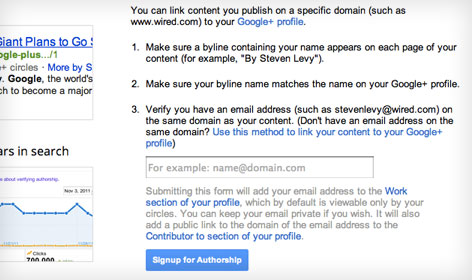Posts Tagged ‘AuthorRank’
Google Authorship for Google+ Users
 Are you noticing photos next to your Google searches? You wondering what it is and how you can have that too for your blog?
Are you noticing photos next to your Google searches? You wondering what it is and how you can have that too for your blog?
Google Authorship adds a photo and other information to the Google search results. However, it does not directly increase ranking. It does make people more likely to click on the results with the author’s photo.
Google Authorship has been reported to increase click thru rates by more than 30%. And a big plus as many people are not currently using this new technology.
Here are the steps required for Google Authorship!
- Get a Google+ account with name and personal photo in the profile. Authorship will not work with any photo besides a clear headshot. The Google+ account should be personal and not a business account.
- The content must have a byline (for example: by Steve Jolly) that exactly matches the name in the Google+ profile.
- Verify the email address. Enter an email address for the same domain as the content. Login in the Google+ Account and Click on Google Authorship to add the email. Open the email from Google and click the verify button in order to link the Google+ account to the content. Notice the verified email address and the domain has been added to the Google+ profile.
- No email with domain name? Manually link the Google+ profile. This is possible, but more troublesome than email verification. Here are instructions on how to link content: Google Support.
Google does not guarantee the placement of Author markup photos, especially if you have a thin site. Authorship takes several days for your picture to start showing. The Google Structured Data Testing Tool can help test the setup.
Google Authorship is also important for the future of Search Engine Marketing. Google is working on implementing AuthorRank, a measure of the popularity of an author. AuthorRank will help content become one of the biggest factors in Google search results.
For more comprehensive read, visit www.SearchEngineLand.com; an article written by Rick DeJarnette.
